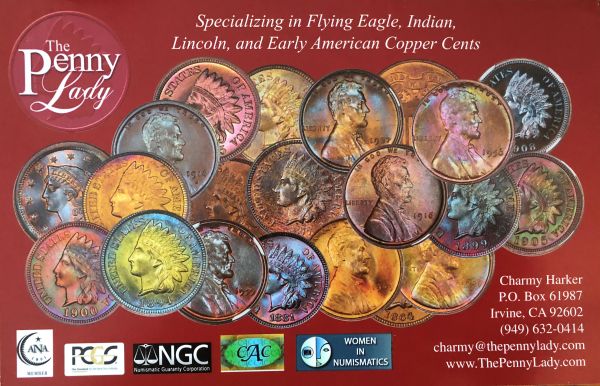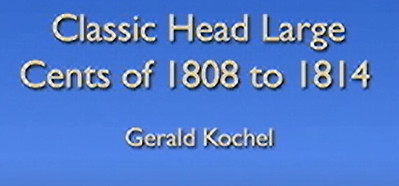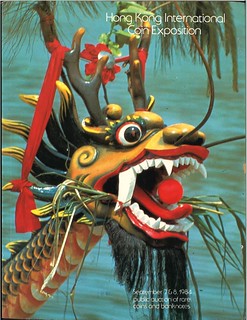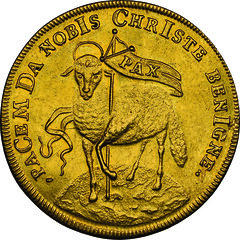
Visit our NBS Sponsors



About UsThe Numismatic Bibliomania Society is a non-profit association devoted to the study and enjoyment of numismatic literature. For more information please see our web site at coinbooks.org SubscriptionsThose wishing to become new E-Sylum subscribers (or wishing to Unsubscribe) can go to the following web page link MembershipThere is a membership application available on the web site Membership Application To join, print the application and return it with your check to the address printed on the application. Print/Digital membership is $40 to addresses in the U.S., and $60 elsewhere. A digital-only membership is available for $25. For those without web access, write to: Jeff Dickerson, Treasurer AsylumFor Asylum mailing address changes and other membership questions, contact Jeff at this email address: treasurer@coinbooks.org SubmissionsTo submit items for publication in The E-Sylum, write to the Editor at this address: whomren@gmail.com BUY THE BOOK BEFORE THE COINSale CalendarWatch here for updates! |
- WAYNE'S WORDS: THE E-SYLUM AUGUST 25, 2024
- ANA AWARDS NBS AND LITERATURE EXHIBITORS
- NEW BOOK: SAMMLUNG FRIEDRICH POPKEN
- FANNING ON EARLY NUMISMATIC PHOTOGRAPHY
- VIDEO: CLASSIC HEAD LARGE CENTS
- ARCHIVING NUMISMATIC WEBSITES
- NOTES FROM E-SYLUM READERS: AUGUST 25, 2024
- VOCABULARY TERM: PRESSES, PART 2
- DEWITT SHELDON SMITH (1840-1908)
- HERITAGE SEPTEMBER 2024 ERROR COIN SHOWCASE
- KUENKER AUCTION SALES 410-411
- THE LöSER COLLECTION OF REGINA ADAMS
- GADOURY OCTOBER 25-26, 2024 SALE, PART II
- TOM KAYS' NUMISMATIC DIARY: AUGUST 25, 2024
- 2024 ANA NUMISMATIC LITERATURE EXHIBITS
- THE COMO, ITALY LATE ROMAN COIN HOARD
- ROMAN GOLD COIN NECKLACE ON PAWN STARS
- ROMAN-ERA SILVER INGOTS
- TALLY STICKS FOR MONEY
- GOODBYE CHECKS, HELLO INSTANT PAYMENTS
- INFLATION-INDEXED BONDS IN EARLY AMERICA
- 19TH CENTURY U.S. PRIVATE GOLD MINTS
- HOW KING CHARLES HELPED CRAFT HIS COINS
- KING CHARLES BANKNOTES CHARITY AUCTION
- ADVENTURES IN COLLECTING DOUBLOONS
- UNION SOLDIERS AWARDED MEDAL OF HONOR
- LOOSE CHANGE: AUGUST 25, 2024
Content presented in The E-Sylum is not necessarily researched or independently fact-checked, and views expressed do not necessarily represent those of the Numismatic Bibliomania Society.
WAYNE'S WORDS: THE E-SYLUM AUGUST 25, 2024
 New subscribers this week include:
Edward Szetela.
Welcome aboard! We now have 7,249 subscribers.
New subscribers this week include:
Edward Szetela.
Welcome aboard! We now have 7,249 subscribers.
Thank you for reading The E-Sylum. If you enjoy it, please send me the email addresses of friends you think may enjoy it as well and I'll send them a subscription. Contact me at whomren@gmail.com anytime regarding your subscription, or questions, comments or suggestions about our content.
This week we open with NBS publication awards and ANA Numismatic Literature exhibit awards, one new book, updates from the Newman Numismatic Portal, notes from readers and more.
Other topics this week include Classic Head Large Cents, DeWitt Smith, error coins, auction previews, a Roman coin hoard, Roman-era silver ingots, tally sticks, checks and instant payments, inflation-indexed bonds, U.S. private gold mints, the coins and banknotes of King Charles III, Mardi Gras doubloons, and the Medal of Honor.
To learn more about the works of David R. Sear, early numismatic photography, archiving numismatic websites, Peale’s Toggle Joint Press, multiple talers from the Thirty Years’ War, Regina Adams, the Mauritz Hallberg Collection, a necklace of Roman gold coins, the tax system in medieval England, the Carolean “definitives”, two Union Civil War heroes, and gift card scams, read on. Have a great week, everyone!
Wayne Homren
Editor, The E-Sylum
ANA AWARDS NBS AND LITERATURE EXHIBITORS
Numismatic Bibliomania Society publications and Numismatic Literature exhibitors garnered awards at the recent ANA convention. NBS President Len Augsburger provided this summary. -Editor
ANA Awards NBS and Literature Exhibitors
In conjunction with the World’s Fair of Money, the ANA announced club publications awards recognizing NBS. The E-Sylum won second place for best electronic club publication, while the print Asylum won third place for best specialty club publication. Congrats to our editors, Wayne Homren and Maria Fanning.
NEW BOOK: SAMMLUNG FRIEDRICH POPKEN
Künker has published a a monograph dedicated to the Friedrich Popken Collection of Brunswick lösers. This overview by Ursula Kampmann appears in Künker's brochure on multiple talers and the Regina Adams collection. -Editor
ZIEGERT, M.
SAMMLUNG FRIEDRICH POPKEN. DIE LÖSER DER BRAUNSCHWEIGISCHEN HERZOGTÜMER 2024
FRIEDRICH POPKEN COLLECTION. THE REDEEMERS OF THE BRUNSWICK DUCHIES 2024
Numismatischer Verlag Fritz Rudolf Künker GmbH & Co. KG: Osnabrück 2024.
176 pages, with numerous color illustrations.
ISBN: 978-3-941357-20-4
Published in One book
 Friedrich Popken is well-known far beyond the borders of
Germany. In the 1980s, he and his wife Ursula had the idea of
creating a company that would produce fashionable clothing
for plus-size women. Today, Ulla Popken GmbH is part of the
Popken Fashion Group, which sells fashion under four different
brands in Europe and the U.S.: Ulla Popken, Gina Laura, JP
1880 and Studio Untold. The origins of the fashion company
date back to 1880, when Johann Popken founded his textile
company in Hameln. Since 2012, the fourth generation of
the Popken family, Astrid Popken and her husband Thomas
Schneider, have been carrying on the torch.
Friedrich Popken is well-known far beyond the borders of
Germany. In the 1980s, he and his wife Ursula had the idea of
creating a company that would produce fashionable clothing
for plus-size women. Today, Ulla Popken GmbH is part of the
Popken Fashion Group, which sells fashion under four different
brands in Europe and the U.S.: Ulla Popken, Gina Laura, JP
1880 and Studio Untold. The origins of the fashion company
date back to 1880, when Johann Popken founded his textile
company in Hameln. Since 2012, the fourth generation of
the Popken family, Astrid Popken and her husband Thomas
Schneider, have been carrying on the torch.
You can find out all this on Wikipedia. However, Wikipedia will not tell you that Friedrich Popken is one of Germany’s most passionate coin collectors. His interests are not only limited to one field – Friedrich Popken has built up various collections over the years. His spectrum ranges from ancient bronze coins to numismatic rarities from Lower Saxony and Northern Germany, coins and medals of the Welf dynasty, the Archbishopric of Salzburg and much more.
FANNING ON EARLY NUMISMATIC PHOTOGRAPHY
The latest addition to the Newman Numismatic Portal is a video of David Fanning's recent presentation to the St. Louis Ancient Coin Study Group. Project Coordinator Len Augsburger provided the following report. -Editor
David Fanning Speaks on Early Numismatic Photography
With many coin clubs moving to virtual meetings during the pandemic, recording and archiving meeting video was a natural step in sharing numismatic knowledge. While most clubs have returned to an in-person format, more than a few have migrated to a “both and” offering, with live meetings held in conjunction with video streaming. The St. Louis Ancient Coin Study Group is one such group, and their meeting video since 2021 is now archived on Newman Portal.
VIDEO: CLASSIC HEAD LARGE CENTS
The David Lisot Video Library on the Newman Numismatic Portal can be found at:
https://nnp.wustl.edu/library/multimediadetail/522852
We highlight one of his videos each week in The E-Sylum. Here's one with my old PAN friend Gerry Kochel speaking about the Classic Head Large Cents of 1808-14. -Editor
ARCHIVING NUMISMATIC WEBSITES
Kavan Ratnatunga writes:
"When a book is published it will last almost forever. How does one publish a numismatic website forever even if not updated? Keep the domain name registered and the website hosted forever. Could an Institution undertake to do that for a financial deposit? It can't be an IT company as it may not exist long-term. It can't be a bank account paying the fees via a deposit as the hosting server may need to be changed."
NOTES FROM E-SYLUM READERS: AUGUST 25, 2024
Shout Out to ANS and NNP
 "This may be of interest to numismatic authors and researchers. I’m writing another book on Chinese coins and went down a few rabbit holes in my search for information about certain provincial coins. But I was pleasantly surprised to find some documents in the American Numismatic Society Library and the Newman Numismatic Portal that could not otherwise be found or contained unexpected information.
"This may be of interest to numismatic authors and researchers. I’m writing another book on Chinese coins and went down a few rabbit holes in my search for information about certain provincial coins. But I was pleasantly surprised to find some documents in the American Numismatic Society Library and the Newman Numismatic Portal that could not otherwise be found or contained unexpected information.
"About the ANS library, it provided me with a Chinese-language article and an auction catalog that I could find nowhere else. (In fact, I couldn’t even find the Chinese-language article on the ANS online catalog, although my poor translation skills may have been the reason). Particular thanks to Librarian David Hill, who very quickly located those materials.
"As for the Newman Numismatic Portal, I found a variety of interesting (and some esoteric) materials in that online resource. One interesting tidbit: century-old U.S. Treasury Department reports that provided economic details about many other countries, including American consular reports identifying the coins circulating in certain Chinese cities. I wasn’t looking for that, but those consular reports are now mentioned in my upcoming book (which will join my two previous books on the general issue ten and twenty cash coins of the early Republic of China)."
Thank you for the report. That's always nice to hear. Keep up the great research work! -Editor
Other topics this week include The Lysander Spooner Award and presses for printing paper money. -Editor
VOCABULARY TERM: PRESSES, PART 2
Here's the second part of Dick Johnson's Encyclopedia of Coin and Medal Terminology entry on Presses and Pressroom Practice. -Editor
Peale’s Toggle Joint Press
Roger W. Budette
When Franklin Peale returned to the Philadelphia Mint from a year-long tour of European mints in May 1835, he had a set of plans for a toggle-joint press with him. These were not copies of Uhlhorn or Thonnelier presses, but were Peale’s inventive spirit applied to the mechanism of the toggle-joint and the problem of efficient mechanized coinage.
Compared to Thonnelier’s or Uhlhorn’s presses, Peale’s version makes more direct application of force and is clearly built on a more robust, compact and simplified application of the same principles. In most respects, Peale seems to have selected the best from European examples, and discarded all unnecessary complexity and ineffective motion. His coin press is simple, direct, somewhat homely in appearance, but entirely effective in operation.
DEWITT SHELDON SMITH (1840-1908)
E-Sylum Feature Writer and American Numismatic Biographies author Pete Smith submitted this article on Massachusetts collector DeWitt Smith. Thanks! -Editor
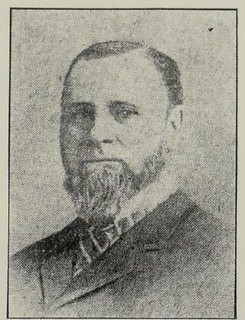 I encourage requests to write an article about someone. When I met with David McCarthy at the
ANA convention, he suggested an article on DeWitt Smith. His name variously appears as
DeWitt, Dewitt or De Witt.
I encourage requests to write an article about someone. When I met with David McCarthy at the
ANA convention, he suggested an article on DeWitt Smith. His name variously appears as
DeWitt, Dewitt or De Witt.
DeWitt Smith was born in Sandisfield, Massachusetts, on April 4. 1840. Records of his ancestry are a bit muddled. I believe some of the links in the FamilySearch site are incorrect. He was probably the son of Jared Smith (1802-1848). His mother was Caroline Julia Sheldon (1810-1845). Both parents died when he was young. He was raised by his grandmother and uncle Elizur. He attended the Deacon Alexander Hyde school and studied civil engineering.
During the Civil War, he served as a second lieutenant with Company H of the 49th Massachusetts Volunteer Infantry. He served as Captain of the company during the battle of Port Hudson.
HERITAGE SEPTEMBER 2024 ERROR COIN SHOWCASE
Here are some selections from Heritage Auctions' upcoming September 16 Error Coin Showcase Auction. -Garrett
(1817) 1C Matron Head Cent, 13 Stars, N-10, R.1 -- Mirror Reverse Brockage on Obverse -- Fine 12 NGC. The reverse is normal, but the obverse displays a first strike brockage of the reverse design. A dentil dots the I in UNITED and the NIT letters step down. Such errors happen when a coin sticks to the obverse die and then acts as a die for the next fed flan. This is a well-circulated deep chocolate-brown example, well centered on both sides.
From The L. William Libbert Collection.
To read the complete item description, see:
(1817) 1C Matron Head Cent, 13 Stars, N-10, R.1 -- Mirror Reverse Brockage on Obverse -- Fine 12 NGC.
(https://coins.ha.com/itm/errors/-1817-1c-matron-head-cent-13-stars-n-10-r1-mirror-reverse-brockage-on-obverse-fine-12-ngc-the-reverse-is/a/60398-52011.s)
KUENKER AUCTION SALES 410-411
Here is the press release previewing the Künker Fall Auction Sales 410-411. More next week on the remaining fall sales. -Editor
Künker’s Fall Auction Sales will feature several world-class special collections. The topics include the Thirty Years’ War, lösers, Württemberg, the German Empire, the Netherlands, Russia, the U.S. and precious individual pieces from the German states and all over the world.
Künker’s Fall Auction Sales will take place from Monday 23 to Saturday 28 September 2024. Every single day is bursting with numismatic highlights, as several special collectors have entrusted Künker with the sale of their treasures, allowing their pieces to re-enter the numismatic cycle. Customers will therefore encounter several world-class collections:
- Auction 410 Minted History of the Thirty Years’ War and the Peace of Westphalia
- Auction 411 A Monetary History of Württemberg – The Heinz-Falk Gaiser Collection, Part 1
- Auction 412 Gold and Silver Coins from Medieval and Modern Times with the Regina Adams Collection of selected lösers, a special collection focusing on Ivan III and an important collection of U.S. gold coins
- Auction 413 German Empire with an important collection from a Mecklenburg private collector as well as imperial gold coins from the collection of an industrial entrepreneur from western Germany
- Auction 414 The Lodewijk S. Beuth Collection of Dutch Coins
Künker’s total estimate for the approximately 3900 lots amounts to 10 million euros. And while we will naturally be highlighting spectacular individual pieces in this preview, no collector should miss out on the opportunity to browse the catalogs carefully. As there are many collections on offer, there are numerous lots with estimates in the two- and low three-digit range.
Künker’s auctions are always a social event. So take the time to participate in the sale on site, and enjoy a nice chat with like-minded people during the breaks! Künker’s customer service would be delighted to help you find an accommodation in Osnabrück.
There is really only one word to describe this collection – breathtaking. Leafing through the almost 400 pages of the catalog, admiring the countless multiple gold coins and multiple talers from the period of the Thirty Years’ War simply takes your breath away. The German manufacturer and history enthusiast who put together this collection over decades did not limit himself to the German players in this war. His focus is on Europe as a whole, which is why his collection paints a dramatic picture of intra-European entanglements.
As a result, all the major and minor protagonists of the Thirty Years’ War can be found on the coins: the Emperor as well as the Swedish, Danish, English and French kings; the Spanish Habsburgs as well as Italian princes. And in terms of beauty, the coins and medals of the United Provinces of the Netherlands compete with those of the German territories. Anyone looking at the material will be in awe of the numismatic splendor created at the transition from the late Renaissance to the early Baroque period.
Künker has taken great care to present this unique collection in its historical context. For this reason, numerous comments on the history of the Thirty Years’ War and its historical figures can be found throughout the catalog.

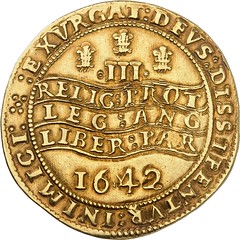
No. 15: England. Charles I, 1625-1649. Triple Unite, 1642, Oxford. Mint mark plumes. Very rare. About extremely fine. Estimate: 40,000 euros


No. 45: Poland. Sigismund III, 1587-1632. 1627 reichstaler, Bydgoszcz. Very rare. Very fine. Estimate: 40,000 euros

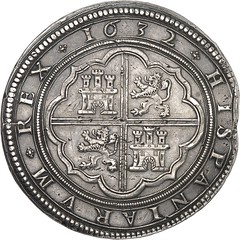
No. 84: Spain. Philip IV, 1621-1665. 1632 cincuentin (50 reales), Segovia. Only 10 specimens known. Very fine to extremely fine. Estimate: 30,000 euros


No. 94: Hungary / Transylvania. Georg Rakoczi, 1630-1648. 10 ducats, 1631, Kolozsvár. Very rare. Very fine +. Estimate: 50,000 euros


No. 132: Habsburg hereditary lands. Ferdinand III, 1625-1637-1657. 10 ducats, 1650, Breslau. Probably unique. Very fine +. Estimate: 75,000 euros


No. 142: County of Schlick. Henry IV, 1612-1650. 10 ducats, 1630. Unique. Extremely fine. Estimate: 100,000 euros


No. 305: German States / Nuremberg. 10 ducats, 1627. Extremely rare. Extremely fine. Estimate: 50,000 euros


No. 409: German States / Holstein-Schauenburg. Justus Hermann, 1622-1635. 4 ducats, 1624. 2nd known specimen. Very fine. Estimate: 50,000 euros


No. 425: German States / Wallenstein. 1627 double reichstaler, Jitschin. Very rare. Very fine. Estimate: 50,000 euros
Are you interested in Württemberg and its coins? In this case, you will be amazed by the Heinz-Falk Gaiser Collection. The avid collector focused on this field for decades. With much patience, expertise and enthusiasm, he succeeded in putting together a world-class collection of Württemberg issues. The first part including 153 lots will be crossing the auction block on 23 September 2024.
It contains Württemberg coins from the beginnings of the 14th century up to 1693, when Eberhard Ludwig was prematurely proclaimed of age. The coins therefore portray the old state of Württemberg, which got caught up in the conflict over Protestantism and partly came under imperial rule.
Like any truly committed specialist collector, Heinz-Falk Gaiser not only looked for rare and precious denominations, but placed equal importance on adding fractional coins to his ensemble. As a result, he was able to acquire many extremely rare denominations of the highest quality available on the market. Although many of them have estimates in the double and low triple digits, his coins are of a quality that both collectors and curators dream of.
It was only on rare occasions that Heinz-Falk Gaiser allowed himself to “get carried away”, as he put it. But since he collected coins for decades, these “rare occasions” were frequent enough to secure some of the great rarities of Württemberg numismatics. Those who are not collectors of Württemberg coinage, but are rather interested in artistic Renaissance pieces will therefore find some numismatic icons of the finest quality. After all, Heinz-Falk Gaiser paid special attention to the quality of his pieces. Therefore, even the ‘only’ very fine issues are often the best specimen of the respective type that exist on the market.


No. 769: Württemberg. Ulrich, 1498-1550. 1507 taler, Stuttgart. “Reitertaler” (horseman taler). Very rare. Probably the finest specimen in private possession. Extremely fine. Estimate: 30,000 euros


No. 800: Württemberg. Louis the Pious, 1568-1593. 1585 taler, Stuttgart, minted from the silver of the Christophtal mine to celebrate his wedding to Ursula von Pfalz-Veldenz. Only 458 specimens minted. Very fine to extremely fine. Estimate: 15,000 euros


No. 830: Württemberg. John Frederick, 1608-1628. 2 ducats, 1623, Stuttgart, minted to celebrate his being appointed Circle Colonel of the Swabian Circle in 1622. Very rare. About extremely fine. Estimate: 15,000 euros


No. 868: Württemberg. Louis Frederick, administrator and guardian of Duke Eberhard III, 1628-1631. 1/2 reichstaler, 1629, Stuttgart-Berg, minted from the silver of the Christophsthal mine. Extremely rare. Extremely fine. Estimate: 15,000 euros
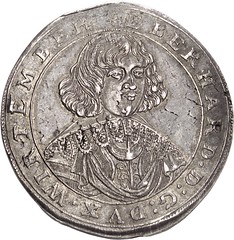

No. 877: Württemberg. Eberhard III, 1633-1674. 1640 reichstaler, Stuttgart-Berg. Very rare. Extremely fine. Estimate: 15,000 euros


No. 888: Württemberg. William Louis, 1674-1677. 1677 reichstaler, Stuttgart. Very rare. Extremely fine. Estimate: 15,000 euros
To order a catalog contact Künker, Nobbenburger Straße 4a, 49076 Osnabrück; phone: +49 541 / 962020; fax: +49 541 / 9620222; or via e-mail: service@kuenker.de. You can access the auction catalogs online at www.kuenker.de. If you want to submit your bid from your computer at home, please remember to register for this service in good time.
THE LöSER COLLECTION OF REGINA ADAMS
This article by Ulrich Künker includes a preview of the upcoming sale of the amazing löser Collection of Regina Adams, displayed recently at the Künker table at the American Numismatic Association convention. -Editor
 We are very proud to present to you this brochure on a
fascinating collecting field of German Numismatics: the lösers.
“löser” is the technical term for a special sort of silver multiples
issued in the 16th and 17th century. They were invented and
used by the House of Welf whose different lineages reigned
the duchy of Brunswick and had at their command the rich
silver resources from the Harz area. Why lösers were invented
and whether they were meant to pay, to present, or to collect,
these are questions still under discussion. Nevertheless, a lot of
new evidence has been collected within the last years. We are
proud to present to you articles of two scholars who will solve
this numismatic enigma for you.
We are very proud to present to you this brochure on a
fascinating collecting field of German Numismatics: the lösers.
“löser” is the technical term for a special sort of silver multiples
issued in the 16th and 17th century. They were invented and
used by the House of Welf whose different lineages reigned
the duchy of Brunswick and had at their command the rich
silver resources from the Harz area. Why lösers were invented
and whether they were meant to pay, to present, or to collect,
these are questions still under discussion. Nevertheless, a lot of
new evidence has been collected within the last years. We are
proud to present to you articles of two scholars who will solve
this numismatic enigma for you.
In any case, do not miss the chance to see some of the most spectacular lösers having been minted in Germany here at the ANA 2024 in Rosemont, Illinois!
GADOURY OCTOBER 25-26, 2024 SALE, PART II
Here is the press release for the October Gadoury sale of many excellent coins, from ancient to American. -Garrett
On 25 and 26 October 2024, Gadoury will hold two auction sales. The second one contains numerous remarkable individual pieces. You can look forward to rarities from antiquity, China, France, Great Britain and Italy as well as a small run of US coins.
After the auction on 25 October 2024 presenting seven collections, another auction sale will be held by Éditions Victor Gadoury on 26 October 2024 featuring about 870 lots with interesting individual pieces.

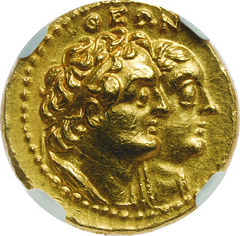
Lot 754: Ptolemy II, 283-246 (Egypt). Quarter mnaieion in gold. From Leu auction 86 (2003), 456. NGC Choice AU* 5/5 4/5 light marks. Estimate: 10,000 euros. Diameter: 17 mm


Lot 766: Roman Republic. Q. Caepio Brutus, one of the conspirators against Caesar. Denarius, Sardes(?), 42 BC. Extremely rare. NGC CHOICE VF 5/5 – 3/5. Estimate: 8,000 euros. Diameter: 17.5 mm


Lot 776: Pertinax, 192-193. Aureus, Rome 123. From fixed-price list Harlan J. Berk (March 1995), No. 227. NGC Gem MS 5/5 5/5 Fine Style. Estimate: 50,000 euros. Diameter: 20.3 mm
Ancient Coins
The auction starts with a small series of Greek coins. Next are interesting pieces of the Roman civil war between Caesar, his successors, and the representatives of the Senate. The highlight is an extremely rare denarius from 42 BC, minted on behalf Brutus in the month prior to the Battle of Philippi.
Those interested in Roman aurei will find a rich selection of above-average quality at Gadoury’s. Even if we can only present one example at this point, a closer look is definitely worth it.


Lot 825: Germany / Brandenburg-Prussia. Frederick William, 1640-1688. Gold medal of 5 ducats celebrating the victory in the Battle of Warsaw on the side of the Swedes against Poland. From the Killisch von Horn Collection, Adolph Hess auction (1904), No. 1252. Very rare. NGC AU DETAILS DAMAGED. Estimate: 10,000 euros. Diameter: 35 mm
Coins of the Holy Roman Empire
A small selection of about 30 lots with coins from Monaco is followed by world coins. Albania is followed by Germany – Allemagne in French – with some interesting gold coins, including a 5-fold ducat with the portrait of the Great Elector. The provenance of this piece issued in 1656 under Frederick William of Brandenburg can be traced back to 1904.
In addition, there is a small interesting series of gold coins form Nuremberg. As an example, we present a triple lamb ducat of 1703.


Lot 877: China. Li Yuanhong. Dollar without year (1912), Wuchang. Extremely rare. PCGS MS65. Estimate: 40,000 euros. Diameter: 39 mm


Lot 878: China. Duan Qirui. Dollar without year (1924), Tientsin. Very rare. GENI MS63. Estimate: 20,000 euros. Diameter: 38 mm
Two Rarities from China
Gadoury offers as many as two Chinese rarities at once. The first one is a 1912 dollar from the mint of Wuchang, depicting on the obverse the portrait of the Chinese statesman Li Yuanhong. It is the rare variety showing Li with military cap. This precious Chinese coin was graded MS65 by PCGS.
A second piece, graded MS63 by the new French grading firm GENI, depicts the portrait of Duan Qirui, Li Yuanhong’s great rival, from the front. The dollar was minted in 1924 in Tientsin, today’s Tianjin.


Lot 911: Spain. Amedeo I, 1871-1873. 100 pesetas, Madrid 1871. From Nomisma auction 47, No. 559. Only 25 specimens minted. NGC AU details, rim filling. Estimate: 50,000 euros. Diameter: 34 mm
Issues from the Spanish Empire
In 1871, only 25 specimens of this rare gold coin of 100 pesetas were minted. This makes the coin a numismatic treasure. Overall, Gadoury has much on offer for all those who are interested in coins of the Hispanic world. 20 lots are from Spain; 32 lots from Mexico and 28 pieces – including numerous gold coins from the 20th century – from Peru.


Lot 951: France. Louis XIV, 1643-1715. Undated gold medal of the chamber of commerce of Lyon. Extremely rare. NGC MS61. Estimate: 30,000 euros. Diameter: 41 mm


Lot 974: France. Napoleon as First Consul. Pattern of 5 francs in gold to commemorate Napoleon’s visit to the Paris mint on 21 Ventôse An XI (= 12 March 1803). From Heritage, Paramount Collection (2021), No. 30175. NGC PROOF 61. Estimate: 50,000 euros. Diameter: 37 mm


Lot 1032: France. Louis Philippe I, 1830-1848. Pattern of 100 francs in gold by Domard, no year (1831). PCGS PROOF 64. TOP POP. Estimate: 100,000 euros. Diameter: 30 mm
France: One of Gadoury’s Specialties
Collectors of French coins are well familiar with the Gadoury auction house since it is the publisher of the most important catalogues on French numismatics of the same name. So it is no surprise that Gadoury also specialises in French coins when it comes to selling coins. From the Merovingians up to 2014, from rare fractional pieces to extensive series of gold coins of the Latin Monetary Union, both royal and féodal – there is hardly a field that will not be covered by the 168 lots with French coins in Gadoury’s autumn sale.
Special highlights are an undated gold medal of the chamber of commerce of Lyon with the portrait of Louis XIV, an essai for the visit of the First Consul Napoleon to the Paris mint in 1803, and an essai of 100 francs in gold by Domard from 1831, graded PROOF64 TOP POP by PCGS.
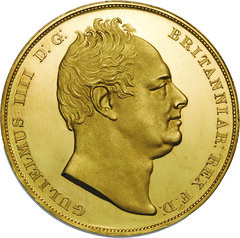

Lot 1106: Great Britain. William IV, 1830-1837. 1831 pattern of 5 pounds, by William Wyon after Chantrey, Rv. by Jean-Baptiste Merlen. Only 6 to 10 specimens minted. Slightly rubbed and worked, otherwise extremely fine. Estimate: 100,000 euros. Diameter: 38 mm
A Gold Pattern for William IV
From the same year – 1831 – is a pattern for the British 5-pound piece issued with the portrait of William IV. Only 6 to 10 specimens of this piece are known of!


Lot 1165: Italy / Milan. Ludovico XII of France, 1500-1513. Double ducat n.d. NGC MS64 TOP POP. Estimate: 40,000 euros. Diameter: 27 mm


Lot 1204: Italy / Papal States. Pius VIII, 1829-1830. 1830 gold medal. Very rare. NGC MS63. Estimate: 25,000 euros. Diameter: 43 mm


Lot 1221: Italiy / Venice. Francesco Contarini, 1623-1624. Zecchino. Extremely rare. About extremely fine. Estimate: 50,000 euros. Diameter: 21 mm


Lot 1235: Italy / Savoy. Carlo Emanuele II, 1638-1675. Under the guardianship of his mother, 1638-1648. 10 scudi in gold, Turin 1641. From the Paramount Collection, Heritage (2021), No. 30383. Extremely rare. NGC AU58. Estimate: 100,000 euros. Diameter: 44 mm
Another of Gadoury’s Specialties: Italy
Those who regularly study Gadoury’s catalogues will know that they do not only specialise in France but also in Italy. And, in fact, once again the auction house presents a wealth of rarities from the various states of the Italian Boot.
At this point, we would like to mention the double ducat from Milan with the splendid renaissance portrait of Louis XII of France, the extremely rare gold medal by Pope Pius VIII, the just as rare zecchino by Francesco Contarini, who did not even remained Doge of Venice for three months, and the extremely rare, perfectly preserved and historically important 10-fold scudi d’oro showing Carlo Emanuele II, Duke of Savoy, with his mother Christine of France.
Of course, experts will also find a rich selection of coins from the Casa Savoia. But see for yourself!


Lot 1394: Russia. Peter III, 1762. 10 roubles, St. Petersburg 1762. Only 25,876 specimens minted. NGC AU53. Estimate: 30,000 euros. Diameter: 32 mm
Peter III and His Rare 10-Fold Gold Rouble
Among the 68 lots with Russian coins – including numerous gold coins from the 19th century – is one of the great rarities of Russian numismatics: the 10-fold rouble by Peter III, minted in 1762 in Saint Petersburg. Only 25,876 specimens were minted and many of them were probably melted down again. The reverse shows the coats of arms of the various territories ruled by the Tsar, not only Moscow and western Russia, but also Astrakhan, Kazan and Siberia, which offered promising new economic opportunities in the mid-18th century.


Lot 1524: USA. 20 dollars, Carson City 1891. Only 5,000 specimens minted. PCGS AU55. Estimate: 15,000 euros. Diameter: 34 mm
Gold Coins from the United States of America
Gold coins from the United States of America are the last large chapter in Gadoury’s auction sale. 121 lots, including mostly 20-dollar pieces of the Liberty type, are waiting for new owners. All coins were graded by PCGS, are from various mints and different years and thus present an ideal opportunity for investors who want to put money into US gold objects.
Please also take a look at our first auction preview with coins from seven different collections.
You can order the catalogue at Éditions Victor Gadoury, 57, rue Grimaldi, 98000 Monaco; phone: +377 93 25 12 96; fax: +377 93 50 13 39; email: contact@gadoury.com.
You can find the catalogue online at auction.gadoury.com, www.sixbid.com and www.numisbids.com. Of course, it is also possible to bid live on your computer at home via www.biddr.ch!
To read the earlier E-Sylum article, see:
GADOURY OCTOBER 25-26, 2024 SALE, PART I
(https://www.coinbooks.org/v27/esylum_v27n33a23.html)
TOM KAYS' NUMISMATIC DIARY: AUGUST 25, 2024
Due to a family event I missed this month's meeting of my Northern Virginia numismatic social club, Nummis Nova. Tom Kays was there and provided this report. Thanks! -Editor
Julian served as host for the August Nummis Nova dinner at Jerry’s Seafood Restaurant (Home of the ‘Crab Bomb’) in Bowie, Maryland. Pictured from the left are Mike Packard, Julian Leidman and his guest Erik Douglas, Tom Kays and Jon Radel. The fact that we met, not in Northern Virginia, but far away across the Potomac River in Maryland, reduced the number of diners in attendance but not the enthusiasm of the group.
2024 ANA NUMISMATIC LITERATURE EXHIBITS
Here are photos of the numismatic literature exhibits at this month's American Numismatic Association summer convention.
First Place: Two Significant Numismatic Entrepreneurs
Exhibitor Erv Brauer kindly forwarded these great photos of his exhibit on Waterman L. Ormsby and Laban Heath. They were taken with the cases open to avoid glare from the glass top. Thank you! Lianna Spurrier filmed Erv speaking about his exhibit for the Newman Numismatic Portal - stay tuned for the video.
THE COMO, ITALY LATE ROMAN COIN HOARD
Discussion of a hoard of Late Roman gold coins found in Como, Italy has popped up on Facebook recently. Here is a news article reporting the discovery, which occurred on September 5, 2018. -Garrett
Archaeologists are studying a valuable trove of old Roman coins found on the site of a former theater in northern Italy.
The coins, at least 300 of them, date back to the late Roman imperial era and were found in a soapstone jar unearthed in the basement of the Cressoni Theater in Como, north of Milan.
“We do not yet know in detail the historical and cultural significance of the find,” said Culture Minister Alberto Bonisoli in a press release. “But that area is proving to be a real treasure for our archeology. A discovery that fills me with pride.”
ROMAN GOLD COIN NECKLACE ON PAWN STARS
Dealer Jeff Garrett recently made an appearance on Pawn Stars, as described in this article from The Sun. -Editor
A FEW unique aspects of jewelry set with gold coins has made it worth hundreds of thousands of dollars.
The set's owner, Jeff, recently brought it in for evaluation by the Pawn Stars, who quickly discovered its jaw-dropping worth.
Jeff, an avid coin collector who'd brought in several pieces to the shop before, met with Pawn Stars' Corey Harrison in the Season 22 episode.
"I've got something that I think is pretty magnificent," he teased.
ROMAN-ERA SILVER INGOTS
Ed Hohertz passed along this article on Roman-era silver ingots. Thank you. -Editor
Three "truly sensational" Roman-era silver ingots depicting Constantine the Great were nearly sold illegally on the internet, a new investigation finds. An unnamed man alleged that his great-grandmother found the rare artifacts buried in the family's backyard in Transcarpathia (also known as Zakarpattia), a region in western Ukraine. Later, the man reportedly tried to sell one of the silver bars online, according to Public Uzhgorod, Ukraine's public broadcast station.
TALLY STICKS FOR MONEY
Pablo Hoffman passed along this Delancey Place blog article about medieval tally sticks, excerpted from Money and Promises by Paolo Zannoni. Thank you. -Editor
For millennia, simple forms of record-keeping have been used as ways to keep track of debt, to substitute for the contemporaneous conveyance of specie, or to accommodate the future settlement and netting of debts. In England, tally sticks were regularly used:
“A tally is usually a stick, or a bone, or a piece of ivory — some kind of artefact — that is used to record information. Palaeolithic tallies include the Lembombo bone, found in the Lembombo Mountains in southern Africa, reported to date from around 44,000 BC; the Ishango bone, which consists of the fibula of a baboon, from the Democratic Republic of the Congo (the former Belgian Congo), thought to be 20,000 years old; and the so-called Wolf bone, discovered in Czechoslovakia during excavations at Vestonice, Moravia, in the 1930s, and estimated to be around 30,000 years old. Marked with notches and symbols, these tallies are ancient recording devices, means of data storage and communication. Not merely artefacts, they are important historical documents.
THE BOOK BAZARRE
GOODBYE CHECKS, HELLO INSTANT PAYMENTS
It was a long road from tally sticks to modern banking, but nothing is constant except change. As the use of checks for payment dwindles, instant payments are on the rise. Here's an excerpt from a recent Time magazine piece - see the complete article online. -Editor
One of the first checks ever recorded was written in the 11th century, in a marketplace in Basra, in present-day Iraq. There, a merchant issued a sakk: written instructions to his bank to make a payment from his account.
A thousand years later, this form of payment is finally disappearing. Target said it would stop accepting checks as of July 15; other retailers, including Whole Foods and Old Navy, have already stopped accepting them. It’s just the latest sign that the form of payment is nearing obsolescence: The average American writes just one check a year, down from 3 in 2016, according to a Federal Reserve survey.
“I absolutely think that we are moving to a world of ‘check zero,’” says Scott Anchin, vice president at the Independent Community Bankers of America. “As we see new payment methods come to the fore, we see new opportunities for consumers and businesses to move away from check usage.”
INFLATION-INDEXED BONDS IN EARLY AMERICA
An article found via News & Notes from the Society of Paper Money Collectors (Volume X, Number 10, August 20, 2024) discusses inflation-indexed Bonds in early America. From the Tontine Coffee-house history of finance blog. -Editor
Colonial America was fertile ground for monetary experimentation. Circulating as money would have been precious metal coins, and not only English coins but also others, paper money issuances from the various colonial governments, often circulating in their neighboring colonies as well, and even commodities widely accepted as money. Many colonies over-issued their paper money, including Massachusetts. The result was depreciation of the money and inflation in prices. Because of this, the government of Massachusetts was ultimately pressured to issue an inflation-linked bond, one that would protect its holder from inflation.
19TH CENTURY U.S. PRIVATE GOLD MINTS
This 2021 Economic History Society article (later published in The Economic History Review) discusses the private gold mints of the U.S. Here's an excerpt - see the complete article online. Also found via News & Notes from the Society of Paper Money Collectors (Volume X, Number 10, August 20, 2024). -Editor
There were three distinct regional gold rushes with private mints: the southern Appalachians, 1830-51, California between 1849-54, and Colorado during 1860-62.
A visitor to the Bechtler mint in North Carolina in 1827 described how ‘country people’ brought in ‘rough gold’ that the mintmaster weighed and recorded in his book, while ‘to others he delivered the coin he had struck’, net of fees, from the gold that they had previously brought. The mint’s operations were like ‘those at a country grist mill, where the miller deducts the toll for the grist he has manufactured’. A mint’s revenue likewise consisted of fees deducted from the metal it ‘fluxed’ (cleaned), assayed to determine fineness, and stamped into coins. The Bechtler mint charged 2.5 percent for assaying and coining. Thus, a miner who brought sufficient gold dust to make $102.50 would receive $100 in new coins.
HOW KING CHARLES HELPED CRAFT HIS COINS
This article from The Sunday Times discusses the new circulating Charles III coins and the King's participation in their design. Here's an excerpt - see the complete article online. -Editor
For many, the death of Elizabeth II almost two years ago was a moment for sombre reflection. For the 1,000 or so staff at the Royal Mint in the Ely Valley near Cardiff, it was also a call to action.
“It was very emotional for us,” says Paul Morgan, the head of coin design, when we meet at the Royal Mint production facility and visitor centre on Thursday. “Everything we produced here had Her Majesty’s effigy on it. But the next morning, I remember looking in the mirror and being hit by the realisation. We’ve got a job to do. And we’ve got to do it well.”
Almost two years on, the results of his labour are glinting before us in a back office at the south Wales site — which combines the dark grandeur of JRR Tolkien’s Mordor with a certain keep-calm-and-carry-on cheer.
KING CHARLES BANKNOTES CHARITY AUCTION
Pablo Hoffman forwarded this piece from The Guardian about the charity auction of the first King Charles banknotes. Thanks. -Editor
A special auction of some of the first banknotes to roll off the presses bearing King Charles III’s face have raised more than £900,000 for charity, more than 11 times their monetary value.
Over the summer, Spink & Sons held four specialist auctions of the new £5, £10, £20 and £50 notes, with the proceeds destined for 10 selected charities.
Collectors are keen to grab the latest banknotes with the lowest possible serial numbers, with the prices paid reflecting interest in the notes that went into circulation in June.
ADVENTURES IN COLLECTING DOUBLOONS
Tom Kays submitted this article on his recent adventures with Mardi Gras throws. Thank you. -Editor
Folks lining parade routes in the Crescent City of New Orleans often call out “Throw me something mister” to the marchers and float riders in the Mardi Gras parade on ‘Fat Tuesday,’ the last day before Lent, when pious folks may give up luxuries (such as foods with meat and sugar) until Easter. As they celebrate, they seek ‘Carnival throws’ of doubloons, strings of beads, medallions, and even larger prizes like plastic cups, and carved Zulu coconuts that are carefully handed down. The Mardi Gras ‘doubloon’ was introduced by H. Alvin Sharpe and became a popular ‘throw’ by Rex (King of Carnival) in the 1960s. These are big coins, the size of pieces-of-eight of old. Hundreds of ‘Krewes,’ private Louisiana and Mississippi social clubs, and Carnival sponsors issue doubloons with mystical designs and group heraldry on one side, and the annual theme of the float, parade marcher’s costumes, or group’s message on the other. Some groups issue multiple designs each year for officers, attendants, and the general public. Aluminum tokens of the same design may be anodized into many rainbow colors. Many have two dates, one for when the group formed, and another for what year Carnival was this design issued.
UNION SOLDIERS AWARDED MEDAL OF HONOR
Last month President Biden awarded Medals of Honor to two Civil War heroes. -Editor
Two Union soldiers who 162 years ago took part in one of America's first special operations were posthumously awarded the Medal of Honor on Wednesday.
"Today we right that wrong. Today they finally receive the recognition they deserve," President Joe Biden said at a White House ceremony.
Descendants of Pvt. George Wilson and Pvt. Shadrach had received a long-awaited call from the White House telling them the Civil War heroes would be awarded the nation's highest military honor for "gallantry and intrepidity" in defense of the Union.
LOOSE CHANGE: AUGUST 25, 2024
Here are some additional items in the media this week that may be of interest. -Editor
An article elsewhere in this issue discusses medieval tally sticks, an early form of money accounting. One of many modern such forms is the ubiquitous gift card (which I seem to receive faster than I can get around to using). This new article from The Conversation examines the dark side of this popular financial product. -Editor
 In gift card fraud, everybody but the victim makes money: fraudsters, gift card companies and retailers. The criminals exploit a rapidly evolving payments industry that’s shrouded in secrecy, designed to ensure easy transactions and lacking in consumer protections.
In gift card fraud, everybody but the victim makes money: fraudsters, gift card companies and retailers. The criminals exploit a rapidly evolving payments industry that’s shrouded in secrecy, designed to ensure easy transactions and lacking in consumer protections.
The technology companies that provide the infrastructure that enables the gift card economy are privately held and release little information publicly. They facilitate payments behind the scenes, out of the view of consumers who see only the brand name of the card and the drugstore or supermarket where they buy it. While retailers who sell gift cards could do more to thwart fraud, the secretive technology companies that set up and manage gift cards are best positioned to stop rampant criminality, but they don’t. There’s no legal requirement to do so, and they make money off the crime.
When consumers put money on a compromised card, the criminals are alerted because they are monitoring the barcodes using automated online account balance inquiries. They can repeatedly check the balances on thousands of barcodes at a time. As soon as money hits a card, the criminals use the account number to purchase items online or in stores, using runners or “mules” to physically go into stores.
To read the complete article, see:
Gift card scams generate billions for fraudsters and industry as regulators fail to protect consumers - and how one 83-year-old fell into the ‘fear bubble’
(https://theconversation.com/gift-card-scams-generate-billions-for-fraudsters-and-industry-as-regulators-fail-to-protect-consumers-and-how-one-83-year-old-fell-into-the-fear-bubble-236439/)
Other topics this week include a massive diamond. -Editor







